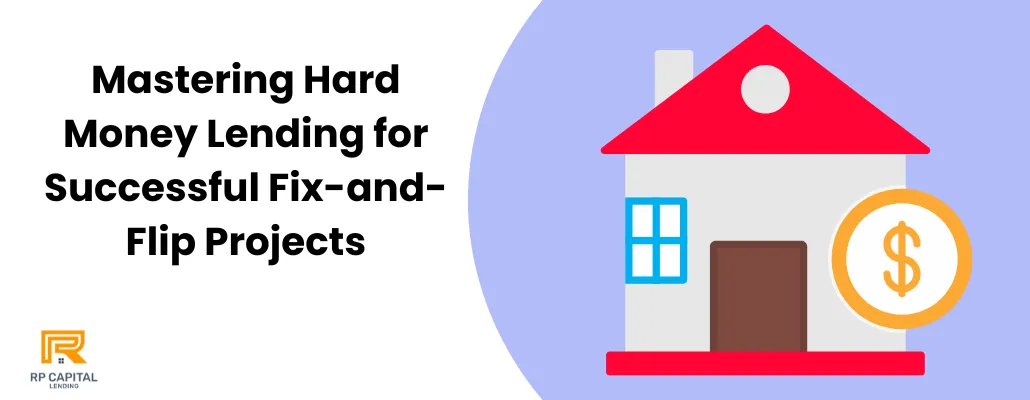Blog

Mastering Hard Money Lending for Successful Fix-and-Flip Projects
In the bustling world of real estate investments, the allure of transforming an underappreciated property into a lucrative fix-and-flip project is irresistible to many. Yet, the path to renovation riches is fraught with financial hurdles. Enter hard money lending—a lifeline for investors seeking agility and flexibility in funding. But how can you navigate this high-stakes terrain with confidence? Let's delve into the essentials of hard money lending for fix-and-flip projects, equipped with insider tips and a dose of practical wisdom.
The Golden Opportunity in Fix-and-Flips
Imagine stumbling upon a property, its potential veiled beneath years of neglect. It's not just a building; it's a canvas for your vision. This is the heart of fix-and-flip projects—where grit meets opportunity. However, the journey from purchase to profit demands more than just vision; it requires capital. Traditional financing often falls short, bogged down by red tape and sluggish processes. Here, hard money lending emerges as the champion for the ambitious investor, offering the swift, flexible funding essential for success.
1. Understanding Hard Money Lending
Hard money loans, typically issued by private investors or companies, are a beacon for real estate investors. Unlike conventional loans, they prioritize the property's value over the borrower's creditworthiness. This focus on collateral simplifies and accelerates the approval process, making it an ideal fit for fix-and-flip ventures. However, the convenience comes at a cost—higher interest rates and shorter repayment terms. Navigating this landscape requires a keen understanding of the terms, benefits, and potential pitfalls.
2. Selecting the Right Hard Money Lender
Not all lenders are created equal. Finding a lender who aligns with your project's goals and timelines is crucial. Seek out lenders with a solid reputation and a track record of supporting successful fix-and-flip projects. Transparency in terms and conditions, responsiveness, and a willingness to build a relationship are key indicators of a lender worth partnering with. Remember, the right lender is not just a source of funds but a strategic ally in your investment journey.
3. Crafting a Convincing Loan Application
Your loan application is your first (and sometimes only) chance to make a compelling case for your project. Include detailed plans, cost estimates, timelines, and potential market analysis. Highlight your experience and past successes in fix-and-flip projects to build credibility. A well-prepared application not only increases your chances of approval but can also lead to more favorable loan terms.
4. Navigating the Flip with Financial Acumen
With funding in hand, the real work begins. Effective budget management is the linchpin of a successful flip. Allocate funds wisely, prioritizing repairs and renovations that offer the highest return on investment. Anticipate unforeseen expenses by setting aside a contingency fund. Staying on schedule is equally important, as delays can inflate costs and erode profits. Keep a tight rein on your project's financial health with regular reviews and adjustments.
5. Exit Strategies and Maximizing ROI
A successful fix-and-flip project culminates in a profitable sale. However, the market is fickle, and not every flip is a straightforward success story. Developing multiple exit strategies—whether it's renting the property, refinancing, or a traditional sale—can safeguard your investment against market volatility. The goal is to maximize your return on investment, not just through the sale price but by minimizing costs and optimizing the timing of your exit.
FAQs on Hard Money Lending for Fix-and-Flip Projects
1: How quickly can I get a hard money loan?
Hard money loans can be secured much faster than traditional loans, often within a few days to a couple of weeks, depending on the lender and the specifics of the deal.
2: Are hard money loans more expensive than bank loans?
Yes, hard money loans typically come with higher interest rates and fees due to the increased risk lenders take and the convenience of quick funding.
3: Can I get a hard money loan with bad credit?
Yes, because hard money loans are primarily secured by the property's value, borrowers with less-than-perfect credit can still obtain financing.
4: What is the typical term for a hard money loan?
Hard money loans are short-term, usually ranging from 6 months to a few years, making them suitable for fix-and-flip projects.
5: How do I repay a hard money loan?
Repayment terms vary, but most hard money loans are interest-only with a balloon payment due at the end of the term, typically paid off by selling the renovated property.
Conclusion: The Path to Fix-and-Flip Success
Hard money lending offers a dynamic financing solution for the fast-paced world of fix-and-flip real estate investments. By understanding the nuances of hard money loans, carefully selecting lenders, and managing your project with financial savvy, you can turn neglected properties into profitable ventures. Remember, each project is a stepping stone in your investment journey, building your experience, reputation, and financial success. With the right approach, the world of fix-and-flip projects can be not just a vision, but a reality.
Disclaimer: Loans only apply to non-owner occupied properties. Rates, terms and conditions offered only to qualified borrowers, may vary upon loan product, deal structure, other applicable considerations, and are subject to change at any time without notice.
Copyright © 2025. All Rights Reserved.


